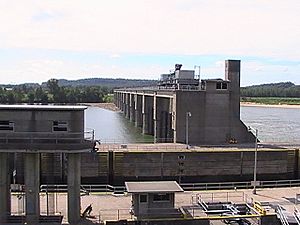Cannelton Locks and Dam facts for kids
Quick facts for kids Cannelton Locks and Dam |
|
|---|---|
 |
|
| Location | Perry County, Indiana / Hancock County, Kentucky US |
| Coordinates | 37°53′59″N 86°42′21″W / 37.89972°N 86.70583°W |
| Status | Operational |
| Construction began | July 1963 |
| Opening date | December 1966 |
| Construction cost | $98 million ($763 million with inflation) |
| Owner(s) | United States Government |
| Operator(s) | US Army Corps of Engineers |
| Dam and spillways | |
| Type of dam | Concrete fixed weir with tainter gate |
| Impounds | Ohio River |
| Height | 42 feet (13 m) |
| Length | 1,827 feet (557 m) |
| Spillway type | 12 tainter gate |
| Reservoir | |
| Tidal range | units |
| Power station | |
| Installed capacity | 84 MW |
| Annual generation | 458 million kWh --> |
| Website US Army Corps of Engineers: Cannelton Locks and Dam |
|
The Cannelton Locks and Dam is a big structure on the Ohio River. It sits on the border between Indiana and Kentucky. This dam helps control the river's water level. It also has two special sections called locks. These locks help boats travel safely along the river.
The Cannelton Locks and Dam is located about 2 miles (3.2 km) southeast of Cannelton, Indiana. The locks started being built in July 1963. They began working in December 1966. The dam itself was started in August 1965 and finished in 1974. The whole project was designed, built, and is still run by the United States Army Corps of Engineers.
Contents
What is the Cannelton Dam?
The Cannelton Dam is located at river mile 720.7. This measurement starts from Pittsburgh, Pennsylvania. The dam has two main parts.
Dam Gates and Weir
The main part of the dam is about 1,412 feet (430 m) long. It has twelve large tainter gates. These gates are like giant doors that can be raised or lowered. They help control how much water flows through the dam. Each gate is 42 feet (13 m) high and 100 feet (30 m) long. Electric machines on top of the dam move these gates.
At one end of the dam, there is a concrete fixed weir. A weir is like a small wall that water flows over. This weir is on the Kentucky side of the river and is about 195 feet (59 m) long.
How Do the Locks Work?
The Cannelton Locks are next to the dam, on the Indiana side of the river. There are two locks that run side-by-side.
Main and Auxiliary Locks
One lock is called the main lock. It is very large, measuring 110 feet (34 m) wide and 1,200 feet (366 m) long. The other lock is the auxiliary lock. It is also 110 feet (34 m) wide but 600 feet (183 m) long.
These locks work like water elevators for boats. They can be filled or emptied in about 8 minutes. This process helps boats move between different water levels.
Water Levels and Efficiency
The water level above the dam (the upper pool) is usually about 383 feet (117 m) above sea level. The water level below the dam (the lower pool) is about 358 feet (109 m) above sea level. This means there is a 25-foot (7.6 m) difference in water height.
To operate one lock, about 25 million US gallons (95,000 m³) of water are needed. These large locks save a lot of time for big commercial boats. Instead of going through three smaller locks, they can now pass through just one large lock. This makes river travel much faster and easier.
Building the Cannelton Dam
The plan for the Cannelton Locks and Dam was approved on January 27, 1960. This approval came from the United States Secretary of the Army. The new dam and locks were built to replace three older locks (Locks 43, 44, and 45). The goal was to improve river navigation.
Construction of the locks started in July 1963. They began operating in December 1966 and were fully finished by April 1967. The dam's construction began in August 1965 and was completed in 1974. The United States Army Corps of Engineers Louisville District was in charge of the entire project.
During construction, about 128 acres (0.52 km²) of land were set aside for viewing areas. In 1995, this land was given to the United States Fish and Wildlife Service. They now use it as a wildlife habitat, helping to protect local animals and plants.
Generating Clean Energy
The Cannelton Dam is also being used to create clean energy. American Municipal Power (AMP) is adding special equipment to the dam. This equipment will use the flowing water to make electricity.
How Hydroelectric Power Works
Water will be sent to three special machines called bulb turbines. These turbines are like giant water wheels. As water flows through them, they spin and generate electricity. This process is called hydroelectric power.
The project includes building a new powerhouse. This building will hold the three turbines. Each turbine can generate 28 MW of power. Together, they can produce a total of 84 MW. This system is expected to create about 458 million kilowatt-hours (kWh) of electricity each year.
Construction for this power project began in 2009. The powerhouse building started in 2011. This big project is estimated to cost around $416 million. It will provide a lot of clean energy for homes and businesses.
| Locks and dams of the Ohio River | ||
|---|---|---|
|
||
| Upstream: McAlpine Locks and Dam |
Downstream: Newburgh Lock and Dam |
|


